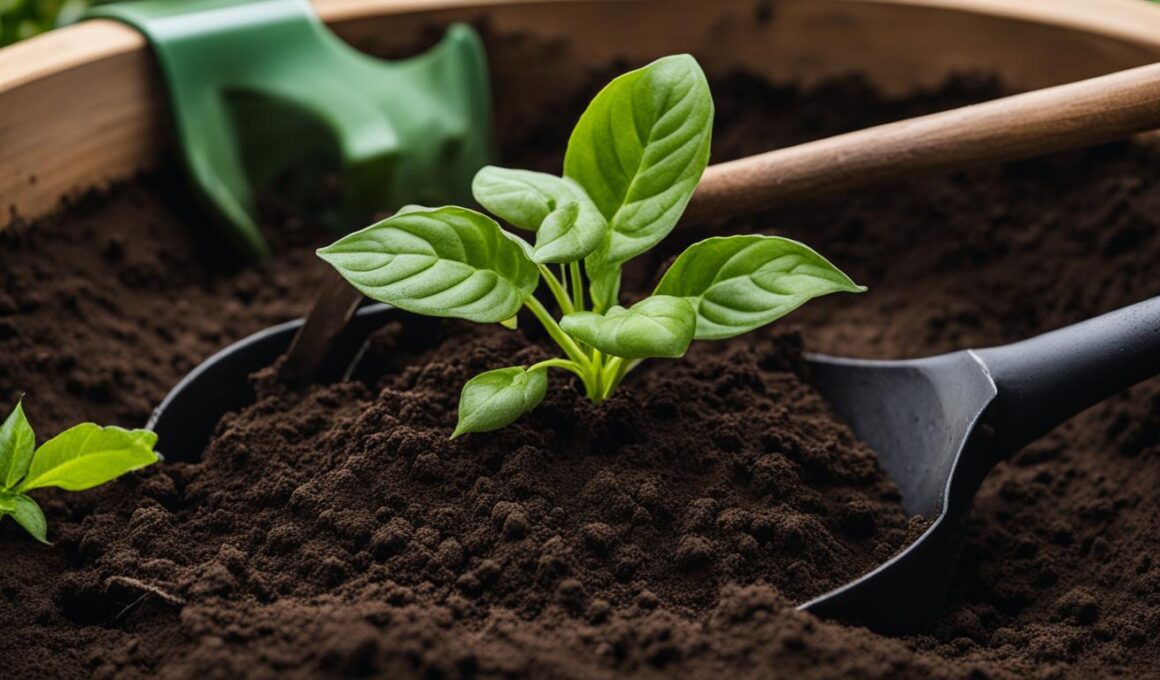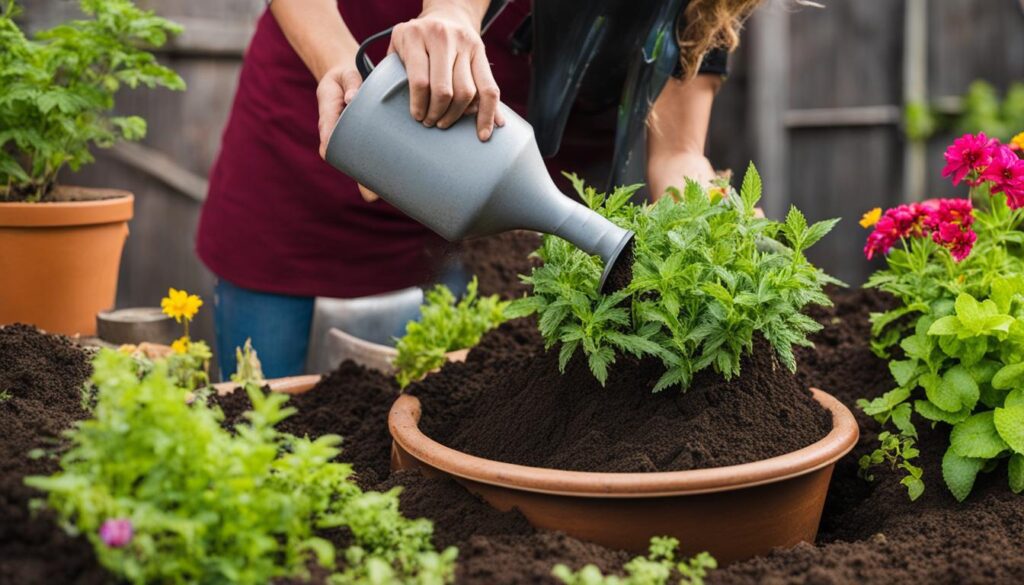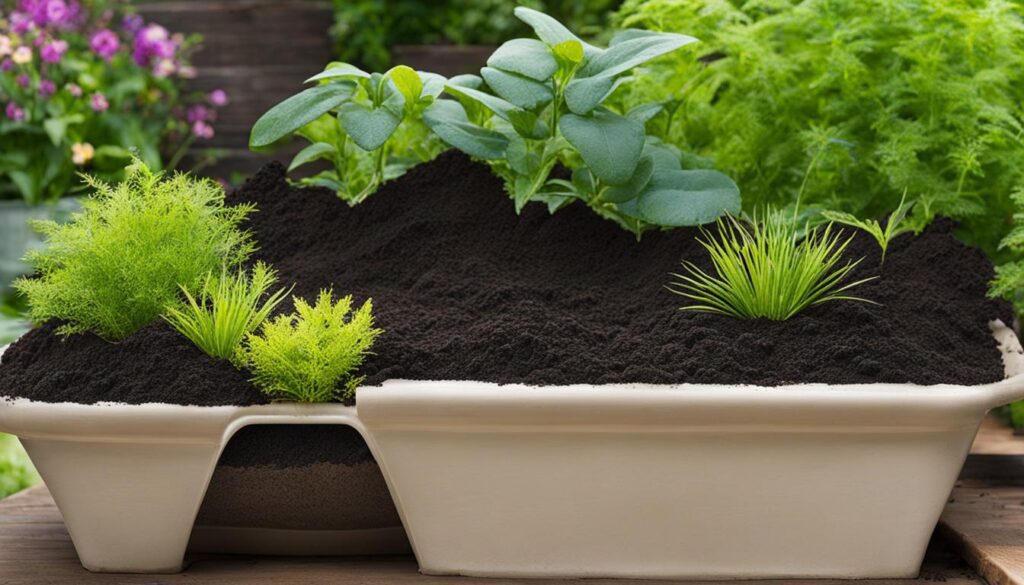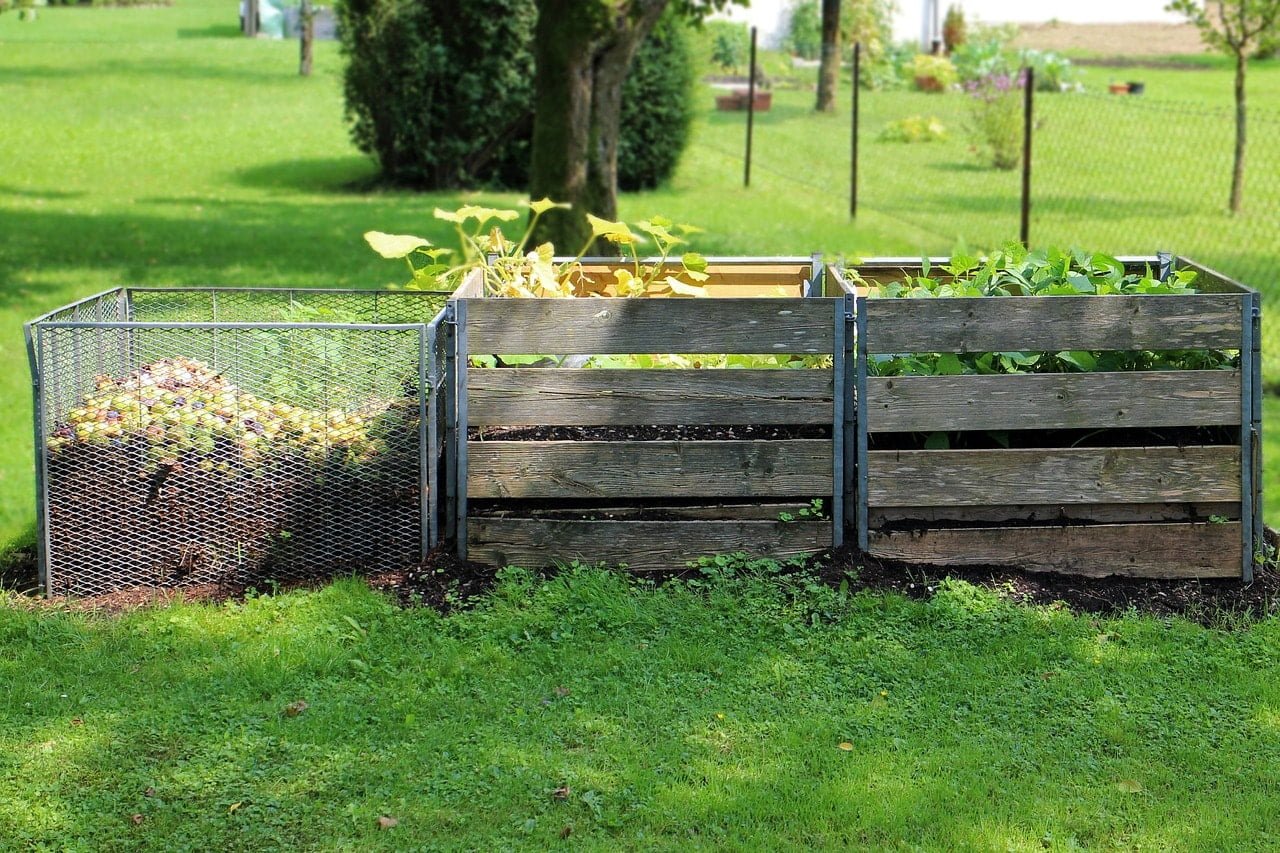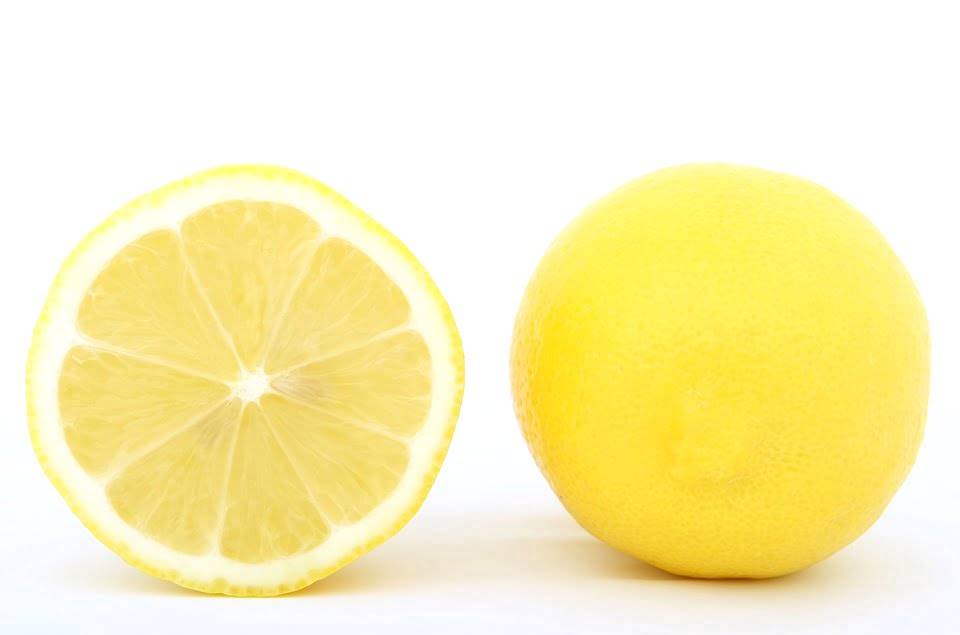When it comes to planting in a 10 gallon pot, it’s important to determine how much soil you need. Various sources provide different measurements and factors to consider. By using these guidelines, you can determine the approximate amount of soil needed for your 10 gallon pot.
Key Takeaways:
- Calculating the amount of soil needed for a 10 gallon pot depends on various factors such as pot size, shape, and compression.
- Consider using potting soil specifically formulated for container gardening to provide the necessary nutrients and drainage for healthy plant growth.
- Estimate the soil amount needed based on approximate measurements and account for soil compression by purchasing slightly more soil than estimated.
- Container gardening offers a convenient way to grow plants, especially in urban environments.
- Choose suitable plants for containers and provide proper drainage and airflow for optimal plant health.
Understanding Pot Sizes and Volumes
When it comes to container gardening, understanding pot sizes and volumes is crucial for successful plant growth. Pot sizes can vary depending on the region, with measurements in inches and gallons commonly used in the United States. In other parts of the world, such as the United Kingdom and Europe, centimeters and liters are the preferred units of measurement.
It’s important to note that the volume of a pot can be influenced by its shape and taper. For example, a pot may have a wider top and narrower bottom, affecting the actual volume it can hold. Additionally, when buying dry potting soil, keep in mind that soil compression can cause an increase of 15 to 20 percent in the volume of the dry soil.
When transplanting a plant into a new container, it’s also essential to consider the existing soil around the roots. This soil will be moved to the new pot and should be taken into account when estimating the amount of soil needed.
Potting Soil Types for Container Gardening
Choosing the right potting soil is crucial for the health and success of your potted plants. Unlike garden soil, which may not be suitable for container planting, potting soil is specifically formulated to provide the necessary nutrients, drainage, and aeration for container plants.
“Potting soil allows for the establishment of a microbial community that supports plant health and nutrient availability.”
Potting soil also allows for the establishment of a beneficial microbial community that supports plant health and nutrient availability. It provides a well-balanced composition of organic matter, perlite, vermiculite, and other components to create an ideal growing environment for potted plants.
Soil Compression and Its Impact
Soil compression is an important factor to consider when estimating the amount of soil needed for your container. During the packaging and transportation of potting soil, it can become compacted, resulting in a reduction in volume. This means that the actual amount of soil you receive may appear less than what is stated on the packaging.
To account for soil compression, it’s recommended to purchase slightly more soil than your estimation. This ensures that you have enough soil to fill your pot adequately. Additionally, it’s important to avoid over-compressing the soil in your container, as it can hinder proper airflow and lead to poor root health.
Estimating Soil Amount for a 10 Gallon Pot
When it comes to planting in a 10 gallon pot, estimating the amount of soil needed is crucial. By following a few simple calculations, you can ensure that your plants have the right amount of soil to thrive. Here’s how you can estimate the soil amount for a 10 gallon pot:
- Start by considering the volume of the pot. A 10 gallon pot is equivalent to approximately 3.785 liters.
- Next, convert the liters to dry quarts. One liter is approximately equal to 1.05668821 dry quarts.
- Now, multiply the dry quarts by the number of gallons to get the total dry quarts needed. In this case, it would be 3.785 liters * 1.05668821 dry quarts = 3.99999967 dry quarts.
- Keep in mind that soil compression can result in a slightly higher volume. It’s always a good idea to add a little extra soil to ensure you have enough.
By following these calculations, you can estimate the approximate amount of soil required for a 10 gallon pot. Remember to consider the specific needs of your plants and adjust the soil amount accordingly. Happy planting!
Additional Tips:
- Use a measuring cup or scale to ensure accurate measurements.
- If purchasing soil in bags, check the label for the volume in dry quarts and adjust accordingly.
- Consider the type of plants you will be growing and their root structure when estimating soil amounts.
- Keep in mind that these calculations are approximate and may vary depending on factors such as soil type, plant species, and pot shape.
Soil Types and Considerations
When it comes to choosing the right soil for your 10 gallon pot, it’s crucial to understand the importance of using potting soil specifically formulated for container gardening. Unlike garden soil, potting soil provides the necessary nutrients, drainage, and aeration for healthy plant growth. It also allows for the establishment of a microbial community that supports plant health and nutrient availability.
Potting soil is designed to have the ideal texture and nutrient composition for potted plants. It is typically a mix of organic matter, such as compost or peat moss, and inorganic materials like perlite or vermiculite. This combination ensures proper water retention and drainage, preventing overwatering or waterlogged roots.
Furthermore, potting soil is free from harmful microbes and pathogens that may be present in garden soil. These harmful elements can lead to diseases in potted plants and hinder their growth. By using potting soil, you create a clean and healthy environment for your plants to thrive.
Factors to Consider
“The composition of the soil plays a significant role in the overall health of your plants.”
When selecting potting soil for your 10 gallon pot, consider the specific needs of the plants you plan to grow. Different types of plants require different soil compositions. For example, succulents prefer a well-draining soil mix with added sand or perlite, while tropical plants thrive in a more moisture-retentive mix with added peat moss or coconut coir.
It is also essential to ensure the potting mix you choose is suitable for the type of container you are using. Some potting soils are specifically formulated for use in raised beds or hanging baskets, offering the necessary structure and moisture retention for these particular setups.
In summary, when selecting the right soil for your 10 gallon pot, opt for potting soil specifically designed for container gardening. Consider the specific needs of your plants and choose a potting mix that provides the ideal composition and drainage for their optimal growth.
Calculating Soil Amount for Different Container Shapes
When it comes to container gardening, understanding how to calculate the amount of soil needed for different container shapes can be a bit tricky. However, with a few general formulas and guidelines, you can easily estimate the soil volume required. Here are some tips to help you determine the right amount of soil for your container:
- For square pots: Multiply the height, width, and length of the pot, and then divide the result by 800. This will give you the approximate number of liters of soil needed.
- For round pots: Square the diameter of the pot, multiply it by the height, and then divide the result by 1800. This will give you the soil volume in liters.
- For irregular or unknown shapes: It’s best to estimate the soil amount or get slightly more to ensure you have enough for planting.
Keep in mind that these formulas are just guidelines, and the actual soil volume may vary depending on factors such as pot taper and soil compression. It’s always a good idea to have a little extra soil on hand to ensure you can fill the container adequately.
Container Gardening Tips
Container gardening offers a range of benefits, including flexibility, space optimization, and decorative possibilities. Here are some additional tips to make your container gardening experience even more successful:
- Choose the right pot size: Consider the space requirements of your plants and choose a pot size that allows for proper root development.
- Ensure proper drainage: Drill holes in the bottom of your containers to allow excess water to drain out. This will prevent waterlogged soil and root rot.
- Use high-quality potting soil: Opt for a potting mix specifically formulated for container gardening. It should provide good drainage, aeration, and the necessary nutrients for plant growth.
- Choose suitable plants: Select plants that are well-suited for container gardening. Consider their light requirements, water needs, and potential size when fully grown.
- Water and fertilize regularly: Container plants may require more frequent watering and fertilizing compared to plants in the ground. Be sure to monitor soil moisture and provide appropriate nutrients.
By following these tips and considering the specific needs of your plants, you can create a thriving container garden that adds beauty and greenery to your space.
Tips and Considerations for Container Gardening
Container gardening is a versatile and convenient way to bring greenery to any space, whether you have a small balcony or a spacious backyard. Here are some tips and considerations to help you make the most of your container gardening experience:
Choose the Right Containers
When selecting containers for your plants, consider the size, material, and drainage capabilities. Opt for containers that are large enough to accommodate the root systems of your chosen plants. Plastic, ceramic, or terracotta pots are common choices, each with their own advantages. Ensure that the containers have adequate drainage holes to prevent waterlogging, which can lead to root rot.
Select Suitable Plants
Not all plants thrive in containers, so it’s important to choose varieties that are well-suited for container gardening. Herbs, leafy greens, and compact vegetables like cherry tomatoes or peppers are popular choices. Flowers such as pansies, petunias, and geraniums also flourish in containers. Consider the amount of sunlight your space receives and choose plants accordingly.
Proper Soil and Watering
Use high-quality potting soil that is specifically formulated for container gardening. This type of soil provides adequate drainage while retaining moisture. Ensure that you water your plants regularly, as containers can dry out quickly, especially during hot summer months. Check the soil moisture by inserting your finger into the soil up to the first knuckle. If it feels dry, it’s time to water. However, be cautious not to overwater, as this can lead to root rot.
Container gardening offers numerous benefits, including the ability to grow plants in limited spaces, easy mobility, and the opportunity to control soil quality and moisture levels. By following these tips and considerations, you can create a thriving container garden that adds beauty and greenery to your home or outdoor space.
Conclusion
Determining the amount of soil needed for your 10 gallon pot can be a challenging task. With variations in container sizes and volumes, it’s important to follow some guidelines to ensure you have the right amount of soil. By considering factors such as soil compression and pot shape, you can estimate the approximate amount required.
Remember to use potting soil that is specifically formulated for container gardening. Regular garden soil may not provide the necessary nutrients and drainage for your plants. Potting soil not only supports healthy plant growth but also allows for the establishment of a beneficial microbial community.
Take into account the specific needs of the plants you plan to grow in your 10 gallon pot. Different plants require different amounts of space and nutrients. By providing adequate drainage and avoiding over-compressing the soil, you can create an optimal environment for your plants to thrive.
How Much Soil Should I Use for Different Plant Sizes in a 10 Gallon Pot?
When deciding how much soil plants need in a 10 gallon pot, consider the size of the plant. For smaller plants, fill about three-quarters of the pot with soil. Medium-sized plants require filling the pot almost to the top, leaving a few inches for watering. Large plants need the pot entirely filled with soil.
FAQ
How do I determine how much soil I need for a 10 gallon pot?
To estimate the amount of soil needed, you can refer to approximate measurements such as 0.46 cubic feet of soil for a 10-inch pot equivalent to 3 gallons of soil. It’s best to purchase slightly more soil than estimated to account for soil compression.
Can I use garden soil instead of potting soil for my 10 gallon pot?
It’s important to use potting soil specifically formulated for container planting. Garden soil may contain harmful microbes and may not provide the necessary nutrients, drainage, and aeration for healthy plant growth.
How do I calculate soil amount for different container shapes?
For square pots, multiply the height, width, and length, and divide the result by 800 to get the number of liters of soil needed. For round pots, square the diameter, multiply it by the height, and divide the result by 1800 to get the soil volume in liters. For irregular or unknown shapes, it’s best to estimate the soil amount or get slightly more to ensure there’s enough for planting.
What are the considerations for container gardening?
When planting in a 10 gallon pot, consider the type of plants you want to grow and their specific space and nutrient requirements. Provide adequate drainage and avoid over-compressing the soil to allow for airflow and root health.





